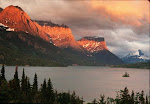Years ago if you saw a photo of a polar bear, the background would almost certainly have been white ice or snow. Pictures like this have become commonplace as some scientists have sought to highlight & dramatise the changing Arctic climate.
For penguins the effects of ice melting in Antarctica are more mixed. Earlier springs mean earlier breeding and more penguins but the increased penguin population is having to swim further to catch fish which are moving to seek colder water.
Rising temperatures may lead to phenomena like algae infesting melting glaciers, as shown here with the Canada Glacier in Antarctica, or bleached coral. Bleaching does not actually kill coral but it does lower its resistance to disease.
The solitary figure in the landscape is in Barrow, Alaska, the northernmost US town, 539kms above the Arctic Circle, where the c. 1,800 residents, mostly Eskimos or Inuit, see no sun from late November to January. The pictured Inuit is from Baffin Island, Canada. Such people are finding food with increasing difficulty because caribou, for example, their staple diet, are falling through the thinning ice cap.
The problem is not confined to polar regions, although they are experiencing the most rapid warming. The picture shows Male, capital of the Maldive Islands in the Indian Ocean. With a maximum elevation of 2.4 metres, the inhabitants have erected a sea wall as protection against a possible rise in sea level.
St Mary's Lake in Montana's Glacier National Park. In 1910 there were 150 glaciers; now there are 30.
Damage caused by Hurricane Ivan in Breeze Point, Florida, 2004. Of course, hurricanes happened before global warming and the tendency to blame all natural disasters, such as the 2005 tsunami, on climaate change are ludicrous.
The greatest natural diasaster of modern times was Krakatoa erupting in 1883, long before anyone dreamt of global warming..
Subscribe to:
Post Comments (Atom)



No comments:
Post a Comment